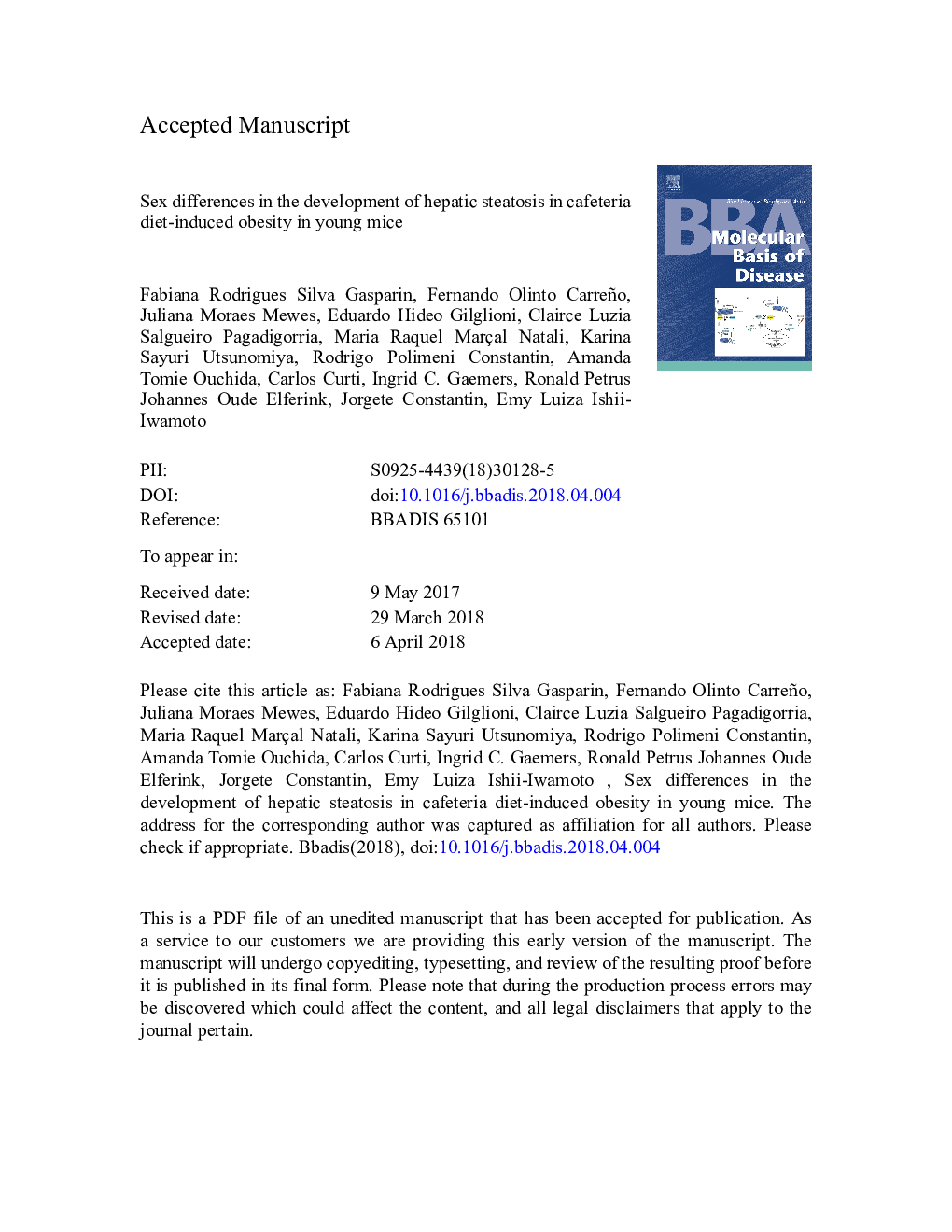| Article ID | Journal | Published Year | Pages | File Type |
|---|---|---|---|---|
| 8258403 | Biochimica et Biophysica Acta (BBA) - Molecular Basis of Disease | 2018 | 40 Pages |
Abstract
The present study was planned to improve our understanding about sex differences in the development of hepatic steatosis in cafeteria diet-induced obesity in young mice. Female (FCaf) and male (MCaf) mice fed a cafeteria diet had similar body weight gain and adiposity index, but FCaf had a more extensive steatosis than MCaf. FCaf livers exhibited a higher non-alcoholic fatty liver disease activity score, elevated lipid percentage area (+34%) in Sudan III staining and increased TG content (+25%) compared to MCaf. Steatosis in FCaf was not correlated with changes in the transcript levels of lipid metabolism-related genes, but a reduced VLDL release rate was observed. Signs of oxidative stress were found in FCaf livers, as elevated malondialdehyde content (+110%), reduced catalase activity (â36%) and increased Nrf2 and Hif1a mRNA expression compared to MCaf. Interestingly, fibroblast growth factor 21 (Fgf21) mRNA expression was found to be exclusively induced in MCaf, which also exhibited higher FGF21 serum levels (+416%) and hepatic protein abundance (+163%) than FCaf. Moreover, cafeteria diet increased Fgfr1, Fsp27 and Ucp1 mRNA expression in brown adipose tissue of males (MCaf), but not females (FCaf). FGF21 hepatic production by male mice seems to be part of a complex network of responses to the nutritional stress of the cafeteria diet, probably related to the unfolded protein response activation. Although aimed at the restoration of hepatic metabolic homeostasis, the branch involving Fgf21 upregulation seems to be impaired in females, rendering them incapable of reducing the hepatic lipid content and cellular oxidative stress.
Keywords
apoBFGF21GPx1ChREBPALTCYP2E1VLDLGCLCHFDNQO1BATHMOX1Cpt1aOPTRNSNOS2NASSOD2ACOX1FGFR1ERKOUPRIRE1GCKXBP1ACC1Sirt1MCAFNAD(P)H dehydrogenase, quinone 1NAFLDATF4SREBP1cMDAFsp27PDK4CATTBA36B4Nrf2acyl-CoA oxidase 1PPARGGSHPPARA18SMTTPTBARSHIF1ao-Phthalaldehyde18S ribosomal RNAROSUcp1ASTAspartate aminotransferaseAlanine aminotransferaseApolipoprotein Bacetyl-CoA carboxylase αHepatic steatosisnonalcoholic steatohepatitisThiobarbituric acidfatty acid synthaseAdipose tissueWhite adipose tissuebrown adipose tissueNonalcoholic fatty liver diseasetriglycerideOxidative stressSex dimorphismhigh-fat dietWestern dietSODMitochondrial superoxide dismutaseSuperoxide dismutaseantioxidant response elementfibroblast growth factor 21Fasnactivating transcription factor 4very low-density lipoproteinglutamate-cysteine ligase, catalytic subunitmalondialdehydethiobarbituric acid reactive substancesNAFLD activity scoreNash AREheme oxygenase 1Unfolded protein responseX-box binding protein 1microsomal triglyceride transfer proteinfat-specific protein 27PERKWATCatalasereduced glutathioneglutathione peroxidase 1Glucokinasereactive nitrogen speciesReactive oxygen speciesFibroblast growth factor receptor 1peroxisome proliferator-activated receptor γperoxisome proliferator-activated receptor α
Related Topics
Life Sciences
Biochemistry, Genetics and Molecular Biology
Ageing
Authors
Fabiana Rodrigues Silva Gasparin, Fernando Olinto Carreño, Juliana Moraes Mewes, Eduardo Hideo Gilglioni, Clairce Luzia Salgueiro Pagadigorria, Maria Raquel Marçal Natali, Karina Sayuri Utsunomiya, Rodrigo Polimeni Constantin, Amanda Tomie Ouchida,
